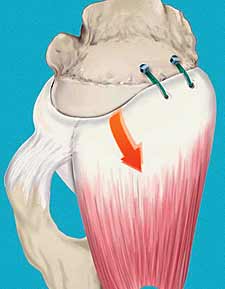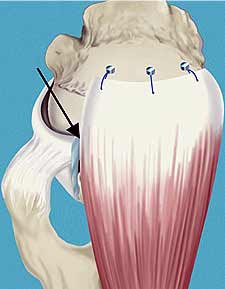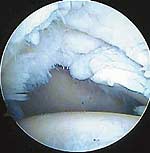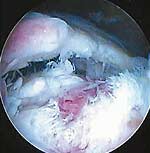Panel shares their insights on rotator cuff repair
Experts consider best-practice approaches and training regimens for this demanding surgery.
Part I: [Leading practitioners share their insights]
With arthroscopic rotator cuff repair looking like it will dominate the field shortly, it is a good time for a refresher on the latest thinking on this procedure. One member of our expert panel below even predicts that four out of five orthopedic surgeons will adopt this procedure as standard treatment in three years. Orthopedics Today asked panel members to consider the top ten questions on technique, sutures, MRIs, subcromial decompression, postoperative courses, complications and other crucial —and not-so-crucial (“When can I play golf”) — issues. Part II appears below.
James Esch, MD
Moderator
| ||||||||||||||||||||||||
James Esch, MD: How do you use MRI scans in your practice?
Joseph Tauro, MD: If a patient fails to improve with conservative treatment, especially if I detect weakness, I order an MRI. Any patient who is going to have surgery gets an MRI. The MRI defines their acromial morphology so I can decide if decompression is necessary. The MRI gives me a very good idea of the size and shape of the tear so I can prepare myself and the patient for what has to be done and what level of recovery can be expected.
|
Stephen S. Burkhart, MD: I routinely get an MRI scan in all patients prior to surgery. If they have had an acute traumatic event or if they were injured at work, I will get the MRI scan early, within the first week or two after injury if the injury seems significant on exam. In older patients, I may consider nonoperative treatment even including corticosteroid injections prior to getting an MRI scan. If the conservative management fails, then I will get an MRI scan prior to any surgery.
Stephen J. Snyder, MD: I use MRI for most patients with suspected RCT. I think it is the most important tool to evaluate the tissues, form a surgical plan and predict the potential of surgical success. I also perform a gadolinium MRI arthrogram if a patient has unusual complaints of shoulder discomfort at 10 to 12 weeks post op. I routinely order a post op MRI arthrogram at 3 months to access the status of all Graft Jacket Allografts.
Richard L. Angelo, MD: We use them routinely for pre-op evaluation of the shoulder noting the rotator cuff tissue quality, cuff tear location, size, extent of retraction/delamination and the magnitude of fatty muscle atrophy. The status of the subscapularis and long head biceps tendon are also noted. Occasionally, the integrity of the rotator cuff repair is evaluated post-operatively using MR arthrograms.
Jeffrey S. Abrams, MD: The MRI can be helpful preoperatively, as well as postoperatively. Preoperatively, the MRI can demonstrate the number of tendons involved, i.e., subscapularis, biceps subluxation, degree of muscular atrophy and fat infiltration, associated pathology including degenerative or chondral changes, and rule out other causes for weakness, i.e., cyst compressing the suprascapular nerve. Postoperative MRI with gadolinium arthrogram is helpful in visualizing the surgical repair or possible disruption in patients with persistent symptoms.
Esch: What are the important aspects of the history and physical exam that are helpful to you?
Burkhart: The history can be important from the standpoint of the patient feeling a pop when he was doing heavy lifting and suddenly having weakness or even the inability to raise the arm overhead. Physical exam is helpful in that external rotation is frequently quite weak if the supraspinatus and/or infraspinatus have been torn.
If the subscapularis is torn, the first test to be positive and the most sensitive test for the upper subscapularis is the bear-hug test, which was recently described by me along with Joe DeBeer. The belly press test can also be quite helpful for subscapularis but the lift-off test is not positive until virtually all the subscapularis is torn.
Other helpful signs include pain with overhead activities and a catching sensation as the patient actively lowers the arm from the overhead position.
|
Snyder: Since I perform all my rotator cuff surgery in the outpatient surgery center, it is important for me to learn the state of the patient’s general health and hence his or her suitability for general anesthesia. Other important information includes the nature and severity of the shoulder symptoms especially concerning activities of daily living, the status of the opposite shoulder and the potential for post-operative rehabilitation.
Angelo: The patient’s history and physical exam help to create an “index of suspicion” for the clinician and help determine how aggressively to work-up a suspected rotator cuff tear. The most helpful history features regarding pain include the following: (1) location; (2) whether it was spontaneous or post-traumatic in onset; (3) duration; and, (4) magnitude (nuisance vs disabling). Weakness, night pain, and a poor response to conservative treatment usually indicate a greater degree of tenonopathy.
Examination findings suggestive of a rotator cuff tear include supraspinatus or infraspinatus atrophy, significant tenderness over the greater tuberosity, and weakness on scapular elevation, external rotation or belly-press tests.
Abrams: Important factors derived by the patient’s history include the onset of symptoms and whether trauma has played a role in tear extension. These factors in combination of an abrupt change in function may be preferable over a chronic prolonged history.
Physical findings include weakness and loss of active motion. Weakness of external rotation is a sensitive finding seen in most tears. Patients with subscapularis tears have weakness of internal rotation as in the lift-off test behind the back or belly-press in front. Atrophy along the scapula and biceps tendon rupture may be found in chronic impingement syndrome.
Esch: What complications have you seen with arthroscopic cuff repair?
Tauro: My complication rates have been quite low. I’ve seen a few anchor pull-outs postop in patients who did not follow directions. The revision repair is never as good! I’ve had one or two deep infections in 13 years of doing these repairs.
There have been no neurological complications that I’ve been able to detect but its hard to know if some weak cuffs after surgery could be due to pre or intraop nerve injuries ... WNL sometimes means “we never looked!”
|
COURTESY OF JOSEPH TAURO |
Burkhart: I have seen complications from acromioplasty, in which too much acromion was removed and acromial fracture occurred. I have seen cases in which an incomplete distal clavicle excision was performed and there were still symptomatic abutment of the distal clavicle against the medial acromial facet. I have also seen occasional infections from arthroscopic rotator cuff repair but these are extremely uncommon. I have seen recurrent tears, and I have seen failure of biologic grafts that were placed to cover defects.
One devastating complication of instability surgery that has been done through an open approach is rupture of the subscapularis repair after it has been taken down for an open instability surgery. These shortened retracted subscapularis tears can be very difficult to address surgically if they have been longstanding.
Snyder: I have seen very few post-operative complications after arthroscopic rotator cuff repair in over 1500 cases. Of course there is the potential for failure of healing or re-tear of the cuff in the post op period. I can recall only four post-op infections. All but one case were all in men over the age of 60 and two had had obvious sources for the infection (urine and skin abcess). There have been a few cases of stiffness and one case where two of five posterior anchors were pulled out of bone at 10 days post-op when an electric muscle stimulator was applied to the cuff by a therapist. There have been no reactions to sutures or anchor problems.
Angelo: Stiffness is one complication and has many possible causes: (1) subacromial scarring; (2) repairing a sizeable defect employing relatively inelastic, scarred cuff tissue; (3) failure to appreciate significant pre-op motion restrictions; and, (4) poor patient rehabilitation efforts, etc.
Loss of anchor fixation — with newer high-strength suture materials and reasonable cuff tissue integrity, the weak link in the repair construct may be the anchor-bone interface.
COURTESY OF RICHARD L. ANGELO |
Abrams: The most common complication is a retear of the repair. This may occur as a tendon failure, suture breakage, or hardware failure. The approach to the retear should focus on the reason for failure, ie, increased tension of repair, premature return to activity. Repeat surgery should be reserved for patients who have demonstrated deficits as the result of the retear and have a surgical situation that has a high chance of improvement with revision surgery.
Other complications include stiffness, hardware complications, and additional pain syndromes involving the biceps, which are relatively uncommon in arthroscopic repairs. Infections are rare and require early recognition.
Esch: There seem to be communities where arthroscopic repair is done routinely and other communities where it is rarely performed? This is similar to the knee arthroscopy meniscus surgery between 1980 and 1990. How does the average orthopedic surgeon learn this technique?
Tauro: Over the last two or three years I’ve seen a real change in the attitude of community orthopedics surgeons in regards to arthroscopic cuff repair. I think everyone realizes its here to stay and has real advantages so they’re getting the training. There are many great hands on courses during the year which are great for this such as your course, Jim. The AANA offers a comprehensive, hands on course several times each year and this is another great way to get trained. Beginners at this should work up to it in stages...from dx arthroscopy to SAD and mini-open to fixing small tears to fixing larger tears.
Burkhart: I think the best way for the orthopedic surgeon to learn the technique is by a combination of things. I think that he should obtain an Alex model and practice all the steps on the model first. Once he is familiar with that, he should attend a hands-on cadaver course such as those produced by the Arthroscopy Association of North America, at the Orthopaedic Learning Center in Chicago. Then he should visit someone who has a large volume of arthroscopic shoulder cases and pickup some hints regarding gaining speed in arthroscopic repair. Then he should begin to do as much as possible arthroscopically with some time limits such as one hour or one-and-a-half hours at which point, he will convert to a mini open repair if he is not finished.
Snyder: I passionately believe that any and all orthopedic surgeons who truly desire to learn arthroscopic rotator cuff repair, or any other type arthroscopic shoulder surgery for that matter need to commit the time and effort to “make it happen.” Of course reading, viewing videos and DVDs and attending courses is a good way to get a baseline understanding of the modern techniques. It is also very important to observe or possibly assist an expert in shoulder arthroscopy in his or her operating room. In my opinion, shoulder arthroscopy is an extremely demanding manual art and can only be perfected by practice followed by more practice.
|
I know that most physicians don’t have access to cadaver parts to use for learning. Cadaver parts are expensive and often poor quality tissue. “ALEX, the shoulder professor” is a plastic shoulder model created by Sawbones Inc. that we now substitute for the cadaver shoulder for all of our arthroscopic shoulder training. Any surgeon may either purchase a model or attend a course that features ALEX and perform the steps of all shoulder reconstructions as often as needed to perfect the steps of the operations. In addition, the Sawbones company now offers an inexpensive arthroscope coupled to a USB or Firewire web camera that connect to a laptop computer to facilitate practice on ALEX without the need for an expensive arthroscopic video system and medical grade scope.
We have built a training center at our Los Angeles office at SCOI called the CLASroom (Center for Learning Arthroscopic Surgery) . This non-profit center was developed for training surgeons in all aspects of arthroscopic shoulder surgery. A visitor can observe surgery, view and copy video cases and perform the surgery on an ALEX model with the help of an expert technician.
Angelo: Arthroscopic rotator cuff repair techniques in themselves are not difficult, but mastery requires a commitment to study, learn and practice the necessary skills as well as a reasonable number of surgical cases to enable progression along the learning curve. Dry lab models and cadaver labs afford the opportunity to learn subacromial anatomy, orientation, portal placement, repair step sequencing and instrument techniques. Finally, a stepwise progression, performing a portion of the procedure arthroscopically and then converting to a mini-open technique allows the surgeon to become proficient and complete key steps in a timely manner as well as evaluate the work performed prior to opening.
Abrams: Orthopedic surgeons will gain the greatest experience utilizing the mini open approach to transition their skills to an all-arthroscopic approach. Techniques to decompress the subacromial space, mobilize tear, and prepare the tuberosity can be performed arthroscopically. Arthroscopic instrumentation, suture management, and knot-tying can be performed through a small deltoid splitting incision. These steps can be performed arthroscopically and confirmed through an open incision as experience improves.
Models to practice suture management and knot-tying are helpful to create confidence to these challenging steps that present themselves during surgery. Cadaver laboratory courses are important for learning-surgeons to experience to complete a repair and open the shoulder afterwards to confirm that surgical restoration has been achieved.
For more information:
- Dr. Burkhart has financial interests in products mentioned in this article and also is a paid consultant for Arthrex Inc.
- Dr. Snyder has a financial interest a number of products mentioned in this series. He also is a paid consultant to Wright Medical Inc.
- Dr. Abrams is a paid consultant to a company mentioned in this article.
- Dr. Esch is a paid consultant to Smith & Nephew.

![James Esch, MD [photo]](/~/media/images/shared-images/james-esch-md-photo.jpg) James Esch, MD,
James Esch, MD,![Jeffrey S. Abrams, MD [photo]](/~/media/images/shared-images/jeffrey-s-abrams-md-photo.jpg)
![Richard L. Angelo, MD [photo]](/~/media/images/shared-images/richard-l-angelo-md-photo.jpg)
![Stephen S. Burkhart, MD [photo]](/~/media/images/shared-images/stephen-s-burkhart-md-photo.jpg)
![Stephen J. Synder, MD [photo]](/~/media/images/shared-images/stephen-j-synder-md-photo.jpg)
![Joseph Tauro, MD [photo]](/~/media/images/shared-images/joseph-tauro-md-photo.jpg)



